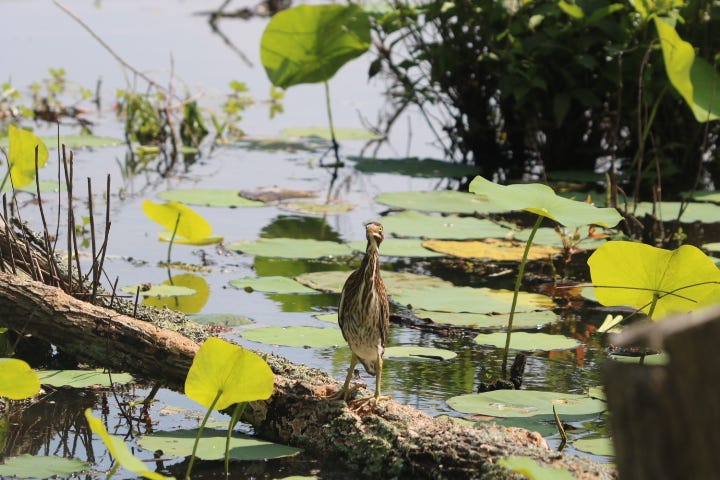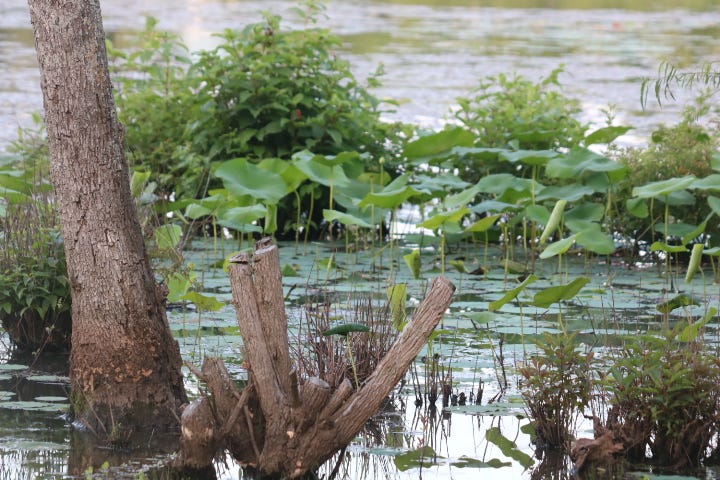Green Heron photographed at Amnicola Marsh on June 9, 2925.
On the morning of June 4, 2025, I visited Amnicola Marsh and recorded the events that transpired. The open, pondlike environment is visible from the north and south sides. The view from the East and West is blocked by forest, but those areas are more like a marsh with aquatic vegetation. In some previous posts, I described how it had largely dried up one summer, but it has rebounded this year.
I brought my camp chair, sketchbook, notebook, and binoculars and prepared for an extended stay. I followed an instruction Barry Lopez included in his writings. Sit in one place and observe. You can read more of his approach to understanding the natural world in “The Naturalist,” published in Orion magazine. Much of this essay comes from time spent sitting on the banks of a river.
From a distance, I heard a Red-winged Blackbird sing “conk-a-ree.” He proclaimed himself king of the marsh, but went silent when I arrived.
After I sat in my chair, he resumed singing. His red and yellow epaulets were barely visible with the wings folded.
The bird landed in the grass a few feet away, searching for small prey. The Cornell Laboratory of Ornithology website tells me that Red-winged Blackbirds eat insects in summer and seeds in winter. They are not above gleaning the leftovers from grain fields and sometimes probe the bases of aquatic plants for insect food.
I saw no female blackbird, so I supposed she was on the nest, which would be in a shrub, just above the water’s surface, or possibly just above land. The females resemble a sparrow and lack the handsome black coat and red and yellow epaulets worn only by male blackbirds. Camouflage comes in handy if you spend the day sitting on a nest.
The flashy male stayed high in a dead tree, singing his loudest. He was, in a blackbird way, defending his territory. Should an intruder arrive, both male and female would team up to protect the nest.
Ducks at Amnicola Marsh, 04.09.2025.
Much as I enjoyed watching the blackbirds, my attention was wholly taken away when the goose family arrived. The adults corralled the five gangly young ones between them. They lacked the cuteness of fluffy yellow goslings, but would soon grow into adult plumage.
I had previously seen these geese and was surprised that all five goslings remained. Goslings are often tasty snacks for herons and snapping turtles. On my previous visit, I watched a Green Heron land on a stump and assume a hunting posture. The goose parents herded the young up the bank and closer to me.
On this day, the goose parents kept their young at the water’s edge, unwilling to approach me closer. They stayed only a short while and swam off.
My next visitor appeared to be a large floating rock, until I looked closely and saw the scutes that adorn the shell of a Common Snapping Turtle. I walked to the shoreline with my binoculars and saw a smaller turtle near the one I first spotted..
Years ago, I worked at a nature center with an exhibit that housed a large Snapping Turtle and an Alligator Snapping Turtle. Neither was anything to fool with, and I know they aren’t gregarious, so I wondered why these two were together.
The larger one raised a head I judged to be about the size of my fist above the water and opened a yellow eye. I know they absorb oxygen through their skin and do not need to come up for air. Snapping Turtles are also not prone to basking in the sun like sliders and cooters.
I don’t know why this one surfaced. Perhaps the beast was looking for a delectable duckling, but they usually ambush prey from below. Soon, the larger turtle swam off, and the smaller one sank below the surface.
I then saw four ducklings, nearly full-grown but without adult plumage. Four others quickly joined the. A female Wood Duck appeared and took up a lead position with the eight following her. The family of Wood Ducks swam across my field of view and disappeared behind the shoreline trees.
I am sure this is the family I saw on my previous visit. The female had eight downy ducklings following her when I last saw them.
They would all look like the mother until winter, when the males would transform into the colorful drakes that make the Wood Duck prized by bird watchers and hunters alike.
They had likely hatched in a hollow tree or one of the wood duck boxes in the marsh. On leaving the nest, they free-fall to the ground and bounce. I have heard that Wood Ducks hatched in incubators must be dropped or they will not thrive.
I remembered to check the open water and saw a stately Great Blue Heron cross my field of view. I saw another fly in the opposite direction and then back.
Then an Osprey flew in and circled over the pond’s center. I only see them here occasionally, but they are more common at nearby Chickamauga Dam. They circle above the tailwaters and descend to catch fish. They nest nearby and winter in South America, but I don’t know the exact location.
This one circled twice over the marsh, descended, and flew off with a small fish. It barely seemed worth the effort.
I was thinking how the day had been one of my best at Amnicola Marsh and preparing to pack up when another Wood Duck swam out of the trees along the shore. Some trees are in the water, but being native willows, they are used to having their roots wet.
Three small balls of fluff followed her. I wished them well, knowing the smaller snapping turtle was still close. I wondered if the duck had lost one or more ducklings this summer.
Just after they swam by, the smaller snapping turtle surfaced. You missed them this time, I thought.
I have since returned to the marsh with my camera, but the wildlife was not as cooperative on those days.
Amnicola Marsh from the South Side, 05.06.2025
Box turtle at Amnicola Marsh, photographed in 2024.
The following is a repost of my long poem, “Renaming the Moons.”
Renaming the Moons
The moon above began as a serious drawing but soon became cartoonish. It is quite different from my recent drawing of a Trillium. It was a gibbous moon to which I added three craters. Seeing the possibilities, I turned it on its side and gave it a crewcut.









This is a wonderful account of a long sit beside a marsh. The earth is grateful.
Beautiful photos and writing.